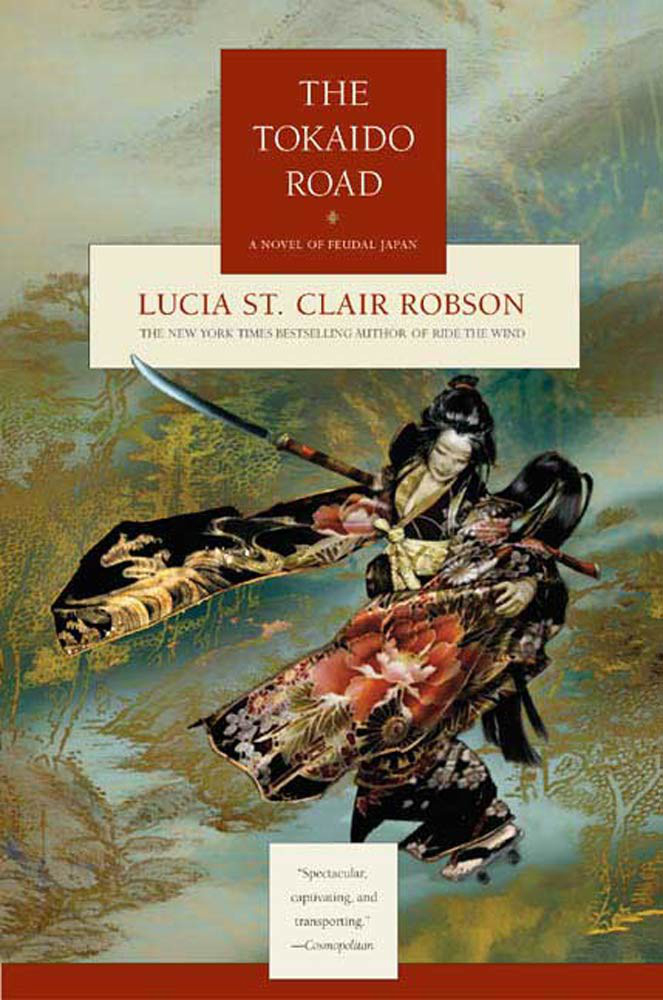Lucia St. Clair Robson
Books: Romance | Historical
The Tokaido Road (1991)
The Tokaido Road (1991)
 Set in Japan in Genroku 15, the Year of the Horse (1702)
Set in Japan in Genroku 15, the Year of the Horse (1702)
Despite my known dislike of boinking books, I am a huge fan of Smart Bitches, Trashy Books. I admit, I was initially a fan for the cover snark, but any site that loves and defends genre fiction, and is blunt and in your face about what they like and don't like about the books they read. I'm still quite hesitant about picking up romance books, but when I read a review of The Tokaido Road, I immediately ordered the book.
Kat works in a pleasure house in Edo. Her father was forced to kill himself after an ugly political intrigue, so as the daughter of an “outside wife”, Kat takes the job to help support her mother. Kat's desire for vengeance against the Kira, the Lord who planned her father's downfall, changes to action when Kira plots against her. She takes to the road and is forced to rely upon her wits and skills she barely knew she had in order to survive and find the man who she hopes will help her take down Kira.
The author did a great deal of research into feudal Japan and the Tokaido Road and the Ako-Asano affair upon which her story is loosely based (Kat and Hanshiro are her creations) and the details are fascinating. We read about not just Kat and Hanshiro's travels, but see glimpses into the lives of many others who lived at that time, from priests and poets to Kubuki actors and peasant pilgrims. (Sorry, those are a lot of Ps there, but didn't do it on purpose, I promise. Wait…)
Kat is a strong woman (my favorite kind to read about) yet does not seem out of time, as strong women sometimes do in historical Romance, and Hanshiro (who is hired to find and return Kat) is fascinating in his own right.
There are so many details I absolutely loved, from the class differences in dress to the description of riding in kago and palanquin (consider: no shocks [I had a similar revelation some years ago about carriages and carts]).
I keep starting sentences, “the other thing I loved…” and then stopping them, because what I ended up loving most were those small details that made the story feel real, from the lives of the peasants to the message boards along the way to contradictory attitudes about sex.
Really, this is a lovely story, and one I highly recommend.
February 2011 | Rating: 9/10
Reread
Set in Japan in Genroku 15, the Year of the Horse (1702)
This story is based upon the real-life events of the revenge of the forty-seven ronin, expanded to follow the daughter of Lord Kiro's outside wife, who has become a courtesan after her father's forced suicide.
The story is full of fascinating historical details.
The collars of her robes were set far back to reveal the most alluring part of a woman's body, the sensuous, vulnerable curve of spine and nape.
As roadside privies went, it was exceptional. Some enterprising farmer had made additions to lure travelers into passing up other privies in favor of his, thus providing more fertilizer for his fields.
The scarf covered the top of his head and dipped onto his brow. It hid the fact that a large circle on the crown of his head was shaved as the government required of actors who impersonated women.
I loved being immersed in all those details.
And the bits that were timeless:
As Hanshiro watched the bright crowds swirl past, he wondered what made people mad for the latest nuance of sash knot or sleeve length. The zeal with which people pursued such absurdities mystified him. Fashions changed, but the mania for being fashionable endured the ages.
I swear I've read something very similar to this in an historical British story.
The priests said bathing symbolized the scrubbing away of evil. It cleansed the soul as well as the body.
I feel that way myself.
It's a lovely story, to be read slowly and savored.
Published by Forge Books
December 2015 | Rating: 8/10
